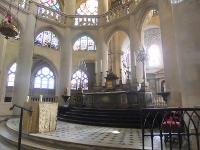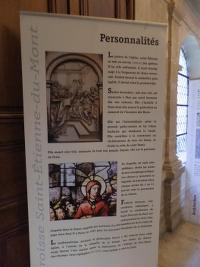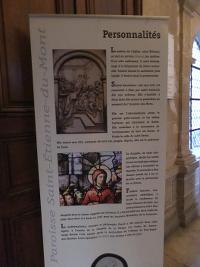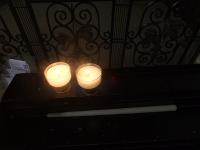***
France/Spain 2011
Day 6 - 22nd March - Paris: Church of St Etienne du Mont (Part 2)

Plaque on the tombs of, among others, Clovis, St Genevieve (patron saint of Paris - the Parisians are very grateful to her, since I only just learned that she was their patron saint)



Altar



Chapel of St Genevieve



Tomb. Her relics were here till 1793.


Rood Screen from the back

On the history of the Church



People associated with the church

About the architecture of the place: the jubé (rood screen) is the only one left in Paris (that was the main reason I visited the church, in fact - I couldn't remember having seen one before)




Quite nice stained glass. Pity it was behind glass.
The stained glass was in where I thought the cloisters were supposed to be


Celebrating Pope Pius VII's visit in 1805



Chapel of the Virgin, behind the altar



Chapel of the Virgin side


More stained glass
Another large draw was the tomb of Blaise Pascal:

Epitaph in Latin

Chapel of the Sacred Heart plaque

Chapel: The Last Supper, Champigneulle, 1889


"The body of Blaise Pascal, who died on 19 August 1662 in this parish of St Etienne du Mont, is inhumed near this pillar. RIP"
This was at the Chapel of the Virgin. For some reason it didn't say exactly where he was buried. Apparently it was "behind the main altar, near to, and directly before the pillar on the left hand, entering the Chapel of the Virgin".



Altar from the rear, and nave



Another chapel
Interestingly, there were parts of the church each dedicated to one saint, and each had a slot for you to donate in the Saint's name. Presumably there was a KPI for each saint. I didn't want to prejudice the count, so I donated into the general church upkeep hole (i.e. with no saint's name)






Tea lights
I decided to light one for Pascal but very intelligently turned an unlit votive candle upside down, and it fell in. I figured out that I should put an existing candle to a new one, instead ofthe reverse.

Guestbook message I left: "Le cœur a ses raisons, que la raison ne connaît point" ("The heart has its reasons, which reason knows not of")
A lot of people use this to describe love or something similar, but really the original quote was about religion: "Le cœur a ses raisons, que la raison ne connaît point. On le sent en mille choses. C'est le cœur qui sent Dieu, et non la raison. Voilà ce que c'est que la foi parfaite, Dieu sensible au cœur." ("The heart has its reasons, which reason knows not of. We feel this in a thousand things. It is the heart which senses God, and not reason. There you have it - that which is perfect faith, God sensed in the heart")